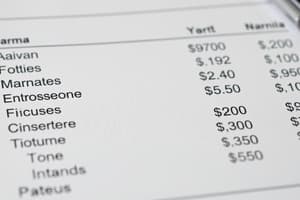Podcast
Questions and Answers
Which of the following items is classified as current liabilities?
Which of the following items is classified as current liabilities?
- Land (in use)
- Income taxes payable (correct)
- Accounts receivable
- Buildings
What is the formula for Current Ratio?
What is the formula for Current Ratio?
- Current Assets / Current Liabilities (correct)
- Current Liabilities / Current Assets
- Current Assets + Current Liabilities
- Total Assets / Total Liabilities
What is the Debt to Assets Ratio?
What is the Debt to Assets Ratio?
Total liabilities / Total assets
What does Free Cash Flow represent?
What does Free Cash Flow represent?
How is Earnings per Share calculated?
How is Earnings per Share calculated?
What is the Going Concern Assumption?
What is the Going Concern Assumption?
What does the Economic Entity Assumption state?
What does the Economic Entity Assumption state?
What is the Monetary Unit Assumption?
What is the Monetary Unit Assumption?
What does the Periodicity Assumption entail?
What does the Periodicity Assumption entail?
What is the Full Disclosure Principle?
What is the Full Disclosure Principle?
What does the Historical Cost Principle refer to?
What does the Historical Cost Principle refer to?
In a classified balance sheet, how are assets usually classified?
In a classified balance sheet, how are assets usually classified?
How are liabilities generally classified on a balance sheet?
How are liabilities generally classified on a balance sheet?
On a classified balance sheet, how are short-term investments classified?
On a classified balance sheet, how are short-term investments classified?
Which of the following would not be classified as a long-term liability?
Which of the following would not be classified as a long-term liability?
How is Equipment classified on the balance sheet?
How is Equipment classified on the balance sheet?
What are generally accepted accounting principles?
What are generally accepted accounting principles?
What does the convention of consistency refer to?
What does the convention of consistency refer to?
What is understandability in the context of financial information?
What is understandability in the context of financial information?
What is the monetary unit assumption?
What is the monetary unit assumption?
Which accounting assumption assumes that an enterprise will continue in operation long enough to carry out its existing objectives and commitments?
Which accounting assumption assumes that an enterprise will continue in operation long enough to carry out its existing objectives and commitments?
Jackson Cement Corporation reported $35 million for sales when it only had $20 million of actual sales. Which quality of useful information has Jackson most likely violated?
Jackson Cement Corporation reported $35 million for sales when it only had $20 million of actual sales. Which quality of useful information has Jackson most likely violated?
What are current assets?
What are current assets?
What are examples of investments?
What are examples of investments?
What are property, plant, and equipment?
What are property, plant, and equipment?
What are intangible assets?
What are intangible assets?
What are current liabilities?
What are current liabilities?
What are long-term liabilities?
What are long-term liabilities?
What is interest expense?
What is interest expense?
What is stockholders' equity?
What is stockholders' equity?
What is confirmatory value?
What is confirmatory value?
What does neutral mean in accounting?
What does neutral mean in accounting?
Study Notes
Financial Statement Items Classification
- Accounts payable: Current liabilities
- Accounts receivable: Current assets
- Accumulated depreciation—equipment: Property, plant, and equipment
- Buildings: Property, plant, and equipment
- Cash: Current assets
- Interest payable: Current liabilities
- Goodwill: Intangible assets
- Income taxes payable: Current liabilities
- Inventory: Current assets
- Stock investments (to be sold in 7 months): Current assets
- Land (in use): Property, plant, and equipment
- Mortgage payable: Long-term liabilities
- Supplies: Current assets
- Equipment: Property, plant, and equipment
- Prepaid rent: Current assets
Key Financial Ratios
- Current Ratio = Current Assets ÷ Current Liabilities
- Debt to Assets Ratio = Total Liabilities ÷ Total Assets
- Free Cash Flow = Net Cash from Operations - Capital Expenditures - Cash Dividends
- Earnings per Share = (Net Income - Preferred Dividends) ÷ Average Common Shares Outstanding
Accounting Assumptions
- Going Concern Assumption: Plant assets not reported at liquidation value due to expectation of ongoing operations.
- Economic Entity Assumption: Personal and business finances maintained separately.
- Monetary Unit Assumption: Dollar used as the measuring stick for financial reporting.
- Periodicity Assumption: Financial information separated into time periods for reporting.
Accounting Principles
- Full Disclosure Principle: Companies must disclose all relevant circumstances impacting financial statement users.
- Historical Cost Principle: Used when reliable fair value estimates are unavailable.
- Convention of Consistency: Consistent use of accounting principles across periods is required.
Balance Sheet Classifications
- Assets classified as: Current assets, long-term investments, property, plant, and equipment, intangible assets.
- Liabilities classified as: Current liabilities and long-term liabilities.
- Short-term investments classified as: Current assets.
Specific Classifications
- Equipment: Classified under property, plant, and equipment.
- Current assets include: Inventory and prepaid insurance.
- Long-term liabilities include: Mortgage payable.
Qualities of Useful Information
- Confirmatory Value: Information that can confirm or adjust previous decisions.
- Faithful Representation: Importance of presenting accurate information; violations lead to misleading reports.
- Understandability: Information must be presented clearly for comprehension.
Specific Financial Concepts
- Current maturities of long-term debt: Not classified as long-term liability.
- Interest expense is not on the balance sheet.
- Stockholders' equity includes retained earnings.
Studying That Suits You
Use AI to generate personalized quizzes and flashcards to suit your learning preferences.
Description
Test your knowledge on financial statement classifications with these flashcards from Accounting I Chapter 2. Each flashcard presents items from Ming Corporation's balance sheet that must be classified correctly. Ideal for students preparing for exams or seeking to reinforce their accounting skills.




